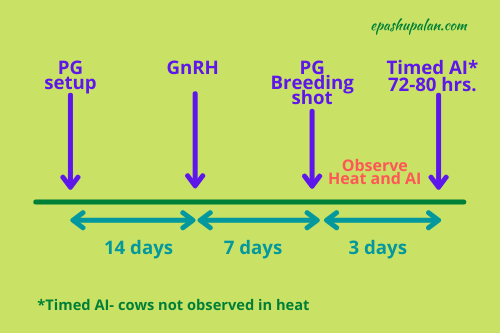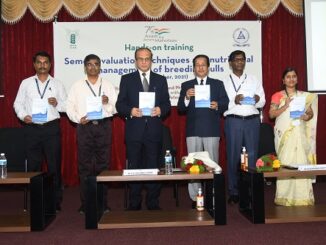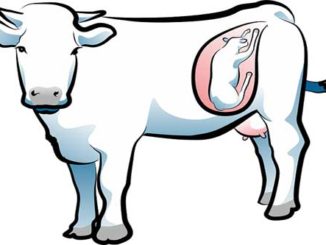In a group of randomly cycling females, the time of occurrence of estrus cannot be predicted with certainty for an individual animal. Detection of estrus is time consuming, laborious and subject to human error. Thus synchronization of estrus in a group of females allows one to predict the time of estrus with reasonable accuracy.
Definition: Synchronization is the process in which we bring group of animals together in estrus within a stipulated period of time.
Advantages of estrus synchronization
- Bring number of animals in estrus with in a fixed time and hence time of estrus can be predicted with reasonable accuracy due to better degree of synchrony
- Avoid human error in detection of estrus by making more vigil in detection during a limited period because still today low pregnancy rate is assigned for failure to detect estrus timely & accurately
- Controlled breeding program allow to detect estrus timely & accurately because reduced the time required for detection of estrus
- Ovulation spread over 84-120 hr post PG
- The ovulation time can be further reduced by 8 hr when a second Gn-RH injection is followed after 48 hr of PG
- Gn-RH1-PG7-Gn-RH9 is known as Ovsynch
- Facilitate the use of artificial insemination.
- Allows supervision of birth
- Permit weaning, fattening and marketing of uniform groups
- Disease control measure can be better implemented
- Facilitate use of MOET.
Factors affecting Synchronization
- Breed
- Nutrition
- Level of milk production
- Post partum interval
- Season of the year
- Type of housing
- Healthy and well nourished animal respond better
- Sudden change in temperature and humidity alter response
- Exposure of cyclic female to sexually mature males or other female in estrus alter response
Selection of animals for Synchronization
- Should have passed 45-50 days of post partum
- Should not be fatty but well nourished
- Should not have any abnormal discharge
- Plan the program in conjunction with A.I persons
- Don’t stress animals during synchronization
Principle of synchronization
In cyclic domestic females, the time of estrus is controlled by secretion of progesterone from the CL. Progesterone exerts negative feedback on LH secretion so that the endocrine events that lead to the maturation of pre-ovulatory follicles and their subsequent ovulation are inhibited until progesterone declines at the time of CL regression. Thus, Synchronization of estrus really means controlling the life span of the corpus luteum, which can be done by
- Reducing the luteal phase by using a luteolytic drug or
- Prolonging the luteal phase using a drug that mimic corpus luteum
Using a luteolytic drug for controlling the life span of CL shorten the natural life span of CL. After administration of luteolytic drug CL regression usually occurs within 24 to 72 hours and estrus and ovulation follows within 2 to 3 days. In all species CL is responsive to luteolytic agents only during certain stages of its development. In ruminants and horse luteolytic agent will not cause regression of CL during first 4 to 6 days of the cycle while in case of pig this period is as high as 12 to 13 days.
Progestagen (progesterone preparation) allows CL to regress naturally during the period when being administered. With this approach, the exogenous progestogen continues to exert negative feedback on LH secretion after CL regression has occurred. After withdrawal of progestogen, follicular growth, estrus and ovulation occur within about 2 to 8 days.
Another way of synchronization of estrus in cyclic animals is through a combination of progestogen and a luteolytic agent. In this approach luteolytic agent causes regression of the CL while progestogen mimic the action of progesterone to prevent estrus until its withdrawal.
Drugs for Synchronization
- Progestagens prepartions
- Progesterone as injectable: require multiple-treatment to maintain physiological concentration and hence difficult eg Duraprogen, Proluton
- Progesterone as oral supplement: difficulty exists with the variable amount of ingestion by the animals resulting in variable blood concentration eg, Melanogestrol acetate (MGA) & Medroxy progesterone acetate (MAP)
- Progesterone releasing devices (sponges): inserted into the vagina allow sufficient absorption of the hormone to maintain physiologic concentrations, however, faces problem of sponge loss & little degree of vaginal infection eg Flurogestone acetate, Medroxy progesterone acetate
- Progesterone as Implant: alone not sufficient for synchronization and thus has been used in conjunction with luteolytic substances such as estradiol valerate eg Syncro-Mate B, Crestar ear implant
- Luteolytic drugs
PGF2α: a luteolytic agent in all species, at least available in three salts
- Cloprosteinol Sodium (250 g/ml, luteolytic total dose, 500g)
- Dinoprost tromethamine ( 5 mg/ml, luteolytic total dose, 25 mg)
- Fenprostalen (0.5g/ml, luteolytic total dose, 1.0 g) its extended long-life (18 hr) makes it’s a popular choice for use in the treatment of pathological condition.
Estrogen: luteolytic in ruminant but not in pigs or horses, works in early and late phase of diestrus. Estradiol valerate is administered as a part of the Syncro-Mate B system for its luteolytic properties.
Synchronization using Progestogen
Long-term progesterone therapy
Given for a period exceeding the inherent lifespan of CL (14-20 days) either as intravaginal sponges and/or coils, progesterone injection or orally active progesterone. This treatment brings majority of the animal in estrus within 2-8 days. The major disadvantage of this system of synchronization is unacceptably low pregnancy rates from the resulting estrus due to any of the reasons as altered follicular dynamics, reduced sperm transport, retarded embryonal development etc.
Short-term progesterone therapy
Given in combination with a luteolytic agents (PGF2α or estradiol valerate) for reducing the duration of treatment. Using Syncro-Mate B(6 g norgestomet + 5 g estradiol valerate) an initial injection of Syncro-Mate B (5g estradiol + 3 g norgestomet) was injected where estradiol is either causing luteolysis or prevent the formation of CL from corpora hemorrhagica present at the time of implantation and injection. The 3 g of norgestomet in the injection is a loading dose of progestogen, maintenance concentrations of which are provided by the implant. Upon removal of the implant on 9th day result in bringing estrus within 4 days. Timed breeding (fixed time insemination) if used is followed after 48 to 54 hr of implants removal. This system is basically suited with cyclic heifers. Norgestomet + PGF2 α: A day prior to implant removal (7 days period) a PGF2 injection is injected i.m. which brings animals in estrus in next 2-3 days. Gives better synchrony as well as conception.
Synchronization using Luteolytic drug
Single injection protocol
This system uses minimum number of doses of PG Animals was observed for estrus three times daily for 5-6 days and those detected in estrus during the period were inseminated. The remaining animals are injected with PG on 6th or 7th day depending on whether a 5 or 6 day breeding period had been used prior to treatment. The estrus detection continues for another 5 to 6 days and animal inseminated on the basis of estrus. With this system most of the cyclic female in a group is inseminated once in 10-12 day period of time. If fixed time insemination is to follow, it is best to give two inseminations, the first at 72 hr and second at 96 hr after treatment.
Double injection protocol
This system can be used in two ways
- Injecting PG in all animals of the group on the first day and are than detected for estrus during the next 5 days. Those detected in estrus during this 5 days period are bred on the basis of estrus. Animals not detected in estrus during the first 5 days are injected again on day 11 or 12. These animals are observed for estrus for 5 days and inseminated in the basis of estrus or are given fixed time inseminations at 72 and 96 hours
- Giving two injections of PG in all animals at 11 or 12 days apart and animals were observed for estrus only after 2nd PG injection for 5 days. hose found in estrus were bred at estrus or given fixed time insemination at 80 hr (single insemination) or at 72 and 96 hr (double insemination). The advantage of this system over single injection system is that a fairly high degree of synchrony is maintained which even last for three-estrus cycle and secondly, less time is consumed on estrus detection.
Factors affecting Synchronization
- Breed of animal, nutrition, level of milk production, post-partum interval, season of the year and type of housing etc affect synchronization.
- Healthy and well-nourished animals respond better compared to undernourished and poor condition animals.
- Sudden change in temperature and humidity alter response
- Exposure of cyclic female to sexually mature males or other female in estrus affect response.
Recent trend in Synchronization
The traditional method of estrus synchronization (controlling cycle length with the most popular methods i.e. PGF2 α or progestin/estradiol or progestin/ PGF2 α) has a draw back in term of variable pregnancy rates and spread of ovulation over a long period. The latest in synchronization technique is to control CL function along with controlling selection of ovulatory follicle and the timing of ovulation which is based on the fact that in an estrus cycle (cow) two-three follicular waves occurs. Controlling the time of emergence of new follicular wave and synchronizing follicular wave status of animals within a group to be synchronized improves the synchrony of estrus and ovulation, which ensure optimum potential for fertilization and embryo development. Thus the latest synchronization technique include synchronization of follicular wave + traditional synchronization protocol.
Follicular wave can be synchronized using Gn-RH. Administration of GnRH during the bovine estrous cycle causes regression or ovulation of the dominant follicle and initiates the emergence of a new wave of follicular growth an average of 2.5 day following treatment. Atresia or ovulation of the dominant follicle depends on the status (growing, static or regressing) of the dominant follicle at the time of GnRH injection. Administration of GnRH 6 or 7 days prior to injection of luteolytic dose of PGF2 α (GnRH- PGF2 α) is presently being used in order to synchronize follicular development prior to regression of the corpus luteum to synchronize estrus. This treatment brings better degree of synchrony compared to double PGF2 α treatment. This treatment works better in beef animal, however, in lactating dairy animals the time of ovulation following G nRH- PGF2 α treatment extend from 84 to 120 h post – PGF2 α. The range in ovulation time could be further reduced to 8 hr (72 to 80 hr post- PGF2 α) by giving a second GnRH injection administered 48 hr after PGF2 α in the GnRH-PGF2 α treatment. Thus
GnRH7- PGF2 α – GnRH2 treatment is termed as ‘Ovsynch’ which synchronizes follicular wave, estrus and ovulation giving better conception rate.
Application of Synchronization techniques in dairy cattle
The major difficulty in obtaining optimum reproductive performance is failure to detect estrus in a timely and accurate manner and therefore in modern dairy practices controlled breeding program are used.
Advantages of Controlled breeding
- Improve efficiency of heat detection
- Achieve more timely first service
- Reduce the variation in calving intervals amongst the animals
- Possibly reduce involuntary culling for reproductive reasons
- Concentrate labor for reproductive management to specific periods
- Improve the pregnancy rate
Prostaglandin Programs
Controlled breeding using ovarian palpation
The program is based on the fact that upon rectal examination if a cow is found to have a responsive CL will be treated with PG injection. Such program could be set up on weekly or biweekly schedule in a farm. With these programs, all cows eligible for breeding after the voluntary waiting period (55 to 75 days) are palpated on a given day of the week. Cow with a CL receive PG and are observed for heat three times daily on 2,3,4 and 5 post-injection. Cow exhibiting standing behavior are inseminated. Cows without a CL and those not observe in heat following the initial PG injection are examined again during the next veterinary visit. The program continues on a routine basis and cows remain on the program until diagnosed pregnant or until a specific number of repeat inseminations have been attempted.
Controlled breeding without ovarian palpation
7-day program
As error in perrectal detection of CL is possible, hence, this option is adopted. Although with this program additional doses of PG is required as some of the cows, which do not have a CL also receive a PG, however, this error is less costly than failure to administer PG to eligible cattle possessing a CL. Thus all cows were injected with PG on a given day of the week. Cattle observed in heat are inseminated and those not seen in heat are re-injected on the same day of the following week. This system is repeated on the third week after which a veterinarian examines the cow. This practice is frequently called, as Monday Morning Program since administering PG on Monday will induce most heats between Wednesday and Saturday. Thus all insemination will occur on week days.
11-day or 14 day program
All eligible cow after the voluntary waiting period receive PG and observed for heat 2 to 5 days after injection and inseminated. Cows that don’t exhibit heat are re-injected 11 days later. At least three such attempts are followed after which the non-responder animals were examined.
Set up PG treatment prior to breeding period (Targeted Breeding)
Cows are administered PG prior to the end of the voluntary waiting period. The purpose is to synchronize (setup) cows into stage of the cycle, when they are most likely to respond to the breeding shot of PG administered 14 days later. At the initial PG injection cow exhibiting estrus are not inseminated. A voluntary waiting period (usually 50-55
days post partum) is established and cows are listed chronologically according to calving dates. Those cows within 14 days of the end of the VWP are administered the setup shot. Fourteen days later the cows receive the first breeding injection of PG and are observed for heat two to five days after injection and inseminated accordingly. Cows that do not exhibit heat are re-injected 14 days later, observed for heat and inseminated. Injections are continued at 14-day intervals until estrus is exhibited.
Modified targeted breeding (GnRH + PG System)
Eligible cows receive PG 21 days before the end of the voluntary waiting period (VWP). This is followed by a GnRH injection 14 days later and a second PG injection 7 days after the GnRH injection. During the three days following the last PG injection cows are inseminated based on observe heat (Fig: 1). Cows not observed in heat by 72 hours post- PG injection are inseminated between 72 and 80 hours. Thus all cows are inseminated.

Ovsynch (GnRH-PG-GnRH Program- Timed AI)
The program includes injection of GnRH seven days later with PG. The GnRH affects follicular growth by causing either ovulation or luteinization of the dominant follicle and prevents estrus until after the PG injection which causes the corpus luteum or lutenized follicle to regress. A new dominant follicle forms as a result of 1st GnRH on 0 day d is available to be ovulated by the second GnRH injection given 48 hours after the PG injection (Fig: 2). The program synchronizes follicular development and ovulation and allows effective timed AI.

Some important points to consider with this program is as follows
- Timing of first GnRH injection is not critical, however, the time of second injection is critical so that insemination could take place at reasonable time of day
- The programme should not be used for heifers
- If a cow exhibits estrus before the completion of the hormonal treatments, she should be inseminate and remaining injection should not be administered
- Program will be useful for cows that simply do not express estrus after several attempts with PG
- The program is also useful in herds where cattle are not turned out for heat detection on a routine basis.
Presynch Program (Ovsynch preceded by PG)
The purpose of this program is to synchronize a group of cows into a stage of their cycle (days 5-12) when they will have a high probability of responding to the Ovsynch system. Approximately 28 days (± 3 days) prior to the initiation of the Ovsynch program a group of cows receive an initial injection of PG. The program can be initiated at a specified number of days postpartum depending on the VWP selected by the farm. Cows can be assigned to the group with± 3 days of the target. This is followed by a second PG injection 14-days later (Fig: 3). There is more number of injections with Presynch program but there is better synchrony of ovulation. Use of bovine somatotropin (bST) either at the time of the initial GnRH injection or at timed insemination has shown beneficial results.

Modern trend in Synchronization
- Controlling CL function along with controlling selection of ovulatory follicle and time of ovulation
- Improve synchrony of estrus & ovulation
- Ensuring optimum potential for fertilization and embryo development
- Synchronization of follicular wave + traditional synchronization
- Controlling CL function along with controlling selection of ovulatory follicle and time of ovulation
- Improve synchrony of estrus & ovulation
- Ensuring optimum potential for fertilization and embryo development
- Synchronization of follicular wave + traditional synchronization







Be the first to comment